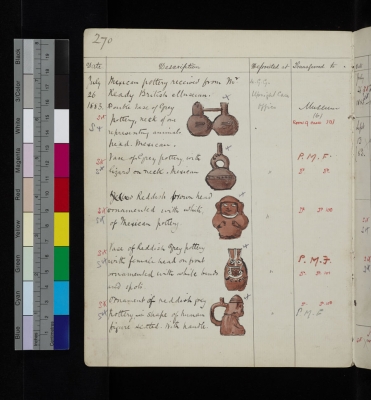To search the RPR site click here
The catalogues offer significant insights into the very wide interests of Pitt-Rivers, and form an important document in the history of collecting ... It is above all the meticulous execution of the illustrations which ... guarentee them a place in the history of archaeological illustration. [Thompson and Renfrew 1999]
In 1880 Pitt Rivers moved to his new estate in Dorset, and suddenly had access to a great deal of disposable income. He had purchased artefacts from friends and colleagues, dealers and auction houses from the 1850s and this continued after 1884 when he agreed to transfer his first collection to the University of Oxford. The catalogues list most, but not all, of his purchases and gifts received between 1880 (when he inherited the estate at Rushmore etc) and 1900 when he died.
The documentation of his collections before 1880 is very scanty. No complete original catalogue exists (or, at least, survives) and only the weaponry parts of his Bethnal Green and South Kensington displays had a published catalogue. The museum authorities at South Kensington did keep partial records of some of the artefacts that were loaned to them by Pitt-Rivers and copies of these records are now held by the Pitt Rivers Museum in Oxford. Until the 1920s, when the founding collection at Oxford was described in detail in several accession registers, information about every object in the founding collection was either non-existent or very scanty.
Everything changed in 1880 when Pitt-Rivers slowly instituted formal cataloguing of his purchases. By his death in 1900 this catalogue would number nine large and beautifully illustrated volumes. The volumes remained in the possession of the Pitt-Rivers' family until the late twentieth century. They are now held in Cambridge University Library and they have graciously permitted this research project to purchase scans of each page of the nine volumes which are available via this website. These were used to create a detailed Filemaker Pro-based database of each artefact which will make searching the information within the volumes much more straightforward.
The catalogue
You can find the Cambridge University Library description of the nine volumes of the catalogue here. [Add.9455]
Quite early on, by 1882 or so, a system had been established and Volume 1 sets the standard which is following, with small improvements, until 1900. It is clear that the volumes continued to be used, and added to, by staff at the museum in Farnham after 1900 though most of the changes after this date appear to relate to the movement of artefacts between rooms in the Museum or between his houses.
In Volume one, each of the pages is divided between four columns:
- Date (of acquisition)
- Description of artefact: This mostly comprises a short description of the appearance and use of the artefact, the source (sometimes) and price (ditto) and an illustration
- Deposited at (that is, where the object was first taken after purchase)
- Transferred to (where the object eventually ended up, or all the different places it rested in)
As time went on, each artefact was examined more closely and drawn more carefully. By volume 3 the quality of the illustrations of many of the artefacts are truly stunning and are discussed further here.
From volume 3 the wording of the catalogue entries changed slightly to:
- Date:
Description of object:
Price:
Deposited at:
Removed to:
And the column headings were now printed into the volumes rather than handwritten. This format continued almost until the end, though in volume 9 a column was added for dimensions of the object. By this point, however, catalogue entries were much less systematic, and most entries are missing at least one category of information. By the last volume some objects were scarcely textually described at all and the drawing became all important. At the very end of volume 9 it is clear that by this point (1899-1900)batch-cataloguing was being done and speed seems to have become the prime objective, presumably because of the back-log of artefacts that required basic cataloguing. This is clear because in the last pages of the catalogue no objects are illustrated and the shortest possible entries for multiple similar objects are written.
Pitt-Rivers probably caused the volume and page number of the catalogue to be written onto the objects, this is certainly the case for one Northwest Coast bow from America which was purchased by a museum in North America and which the author traced back to the CUL volumes by the reference the new owner museum had found written on it. You can find out more about the documentation used by Pitt-Rivers for his second collection here.
AP, 26 April 2010, updated September 2010 and again in March, June 2011.




